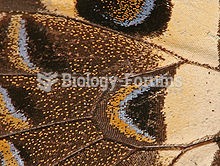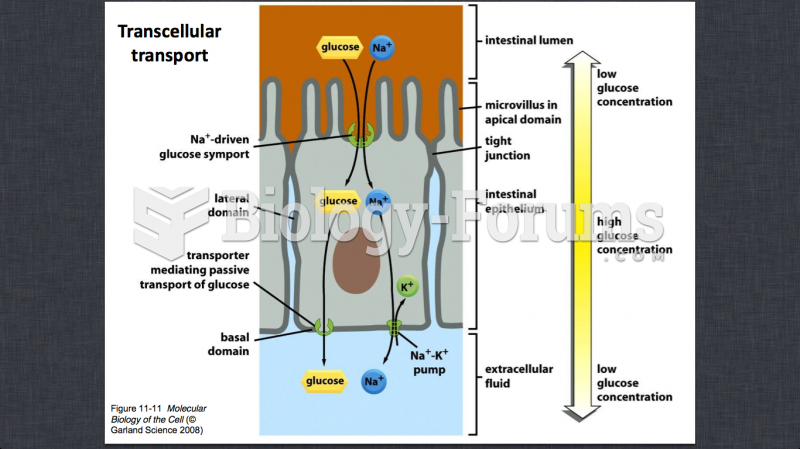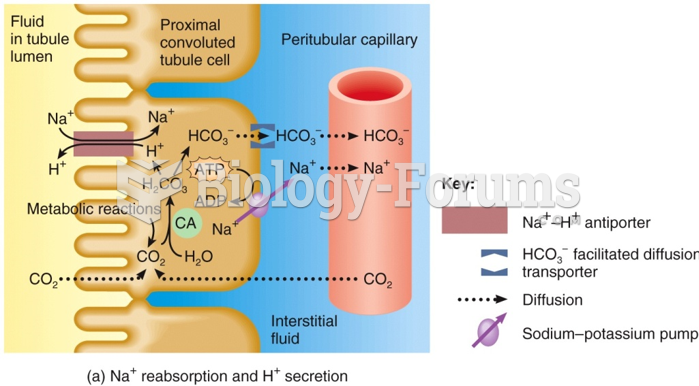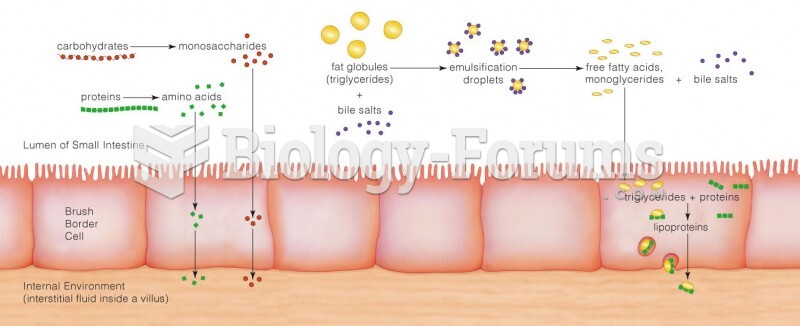Answer to Question 1
Fat digestion starts off slowly in the mouth, with some hard fats beginning to melt when they reach body temperature. A salivary gland at the base of the tongue releases an enzyme (lingual lipase) that plays an active role in fat digestion in infants, but a relatively minor role in adults. In infants, this enzyme efficiently digests the short- and medium-chain fatty acids found in milk.
In a quiet stomach, fat would float as a layer above the watery components of swallowed food. But whenever food is present, the stomach becomes active. The strong muscle contractions of the stomach propel its contents toward the pyloric sphincter. Some chyme passes through the pyloric sphincter periodically, but the remaining partially digested food is propelled back into the body of the stomach. This churning grinds the solid pieces to finer particles, mixes the chyme, and disperses the fat into small droplets. These actions help to expose the fat for attack by the gastric lipase enzymean enzyme that performs best in the acidic environment of the stomach. Still, little fat digestion takes place in the stomach; most of the action occurs in the small intestine.
When fat enters the small intestine, it triggers the release of the hormone cholecystokinin (CCK), which signals the gallbladder to release its stores of bile. (Remember that the liver makes bile, and the gallbladder stores bile until it is needed.) Among bile's many ingredients are bile acids, which are made in the liver from cholesterol and have a similar structure. In addition, bile acids often pair up with an amino acid (a building block of protein). The amino acid end is hydrophilic, and the sterol end is hydrophobic. This structure enables bile to act as an emulsifier, drawing fat molecules into the surrounding watery fluids. There, the fats are fully digested as they encounter lipase enzymes from the pancreas and small intestine.
Most of the hydrolysis of triglycerides occurs in the small intestine. The major fat-digesting enzymes are pancreatic lipases; some intestinal lipases are also active. These enzymes remove each of a triglyceride's outer fatty acids one at a time, leaving a monoglyceride. Occasionally, enzymes remove all three fatty acids, leaving a free molecule of glycerol.
Phospholipids are digested similarlythat is, their fatty acids are removed by hydrolysis. The two fatty acids and the remaining glycerol and phosphate fragments are then absorbed. Most sterols can be absorbed as is; if any fatty acids are attached, they are first hydrolyzed off.
Most of the bile is reabsorbed from the small intestine and recycled. The other possibility is that some of the bile can be trapped by dietary fibers in the large intestine and excreted. Because cholesterol is needed to make bile, the excretion of bile effectively reduces blood cholesterol. The dietary fibers most effective at lowering blood cholesterol this way are the soluble fibers commonly found in fruits, whole grains, and legumes.
Small molecules (glycerol and short- and medium-chain fatty acids) can diffuse easily into the intestinal cells; they are absorbed directly into the bloodstream. Larger molecules (monoglycerides and long-chain fatty acids) are emulsified by bile, forming spherical complexes known as micelles. The micelles diffuse into the intestinal cells, where the monoglycerides and long-chain fatty acids are reassembled into new triglycerides. Within the intestinal cells, the newly made triglycerides and other lipids (cholesterol and phospholipids) are packed with protein into transport vehicles known as chylomicrons. The intestinal cells then release the chylomicrons into the lymphatic system. The chylomicrons glide through the lymph until they reach a point of entry into the bloodstream at the thoracic duct near the heart. The blood carries these lipids to the rest of the body for immediate use or storage. A look at these lipids in the body reveals the kinds of fat the diet has been delivering. The blood, fat stores, and muscle cells of people who eat a diet rich in unsaturated fats, for example, contain more unsaturated fats than those of people who select a diet high in saturated fats.
The chylomicrons are one of several clusters of lipids and proteins that are used as transport vehicles for fats. As a group, these vehicles are known as lipoproteins, and they solve the body's challenge of transporting fat through the watery bloodstream. The body makes four main types of lipoproteins, distinguished by their size and density. Each type contains different kinds and amounts of lipids and proteins. The more lipids, the less dense; the more proteins, the more dense.
When fat enters the small intestine, it triggers the release of the hormone cholecystokinin (CCK), which signals the gallbladder to release its stores of bile. (Remember that the liver makes bile, and the gallbladder stores bile until it is needed.) Among bile's many ingredients are bile acids, which are made in the liver from cholesterol and have a similar structure. In addition, bile acids often pair up with an amin
Answer to Question 2
During hydrogenation, some or all of the points of unsaturation are saturated by adding hydrogen molecules. Hydrogenation offers two advantages. First, it protects against oxidation (thereby prolonging shelf life) by making polyunsaturated fats more saturated. Second, it alters the texture of foods by making liquid vegetable oils more solid (as in margarine and shortening). Hydrogenated fats improve the texture of foods, making margarines spreadable, pie crusts flaky, and puddings creamy. Total hydrogenation rarely occurs during food processing. Most often, a fat is partially hydrogenated, and some of the double bonds that remain after processing change their configuration from cis to trans.
In nature, most double bonds are cismeaning that the hydrogens next to the double bonds are on the same side of the carbon chain. Only a few fatty acids (notably a small percentage of those found in milk and meat products) naturally occur as trans-fatty acidsmeaning that the hydrogens next to the double bonds are on opposite sides of the carbon chain. In the body, trans-fatty acids behave more like saturated fats, increasing blood cholesterol and the risk of heart disease







